John Donne, in the fifth of his elegies, addresses the interlinked themes of painting and remembrance. The poem is written from the perspective of a lover who has just given his beloved a portrait of himself:
“Here take my Picture; though I bid farewell,
Thine, in my heart, where my soule dwells, shall dwell.
‘Tis like me now, but I dead, ‘twill be more
When we are shadowes both, than ‘twas before.
When weather-beaten I come backe; my hand,
Perhaps with rude oares torne, or Sun-beams tann’d,
My face and brest of hairecloth, and my head
With cares rash sodaine stormes, being o’erspread,
My body a sack of bones, broken within;
And powder’s blew staines scatter’d on my skinne;
If rivalls taxe thee to have lov’d a man,
So foule, and coarse, as, Oh, I may seeme then,
This shall say what I was…”
The kind of painting that the poet had in mind when he wrote those lines was a portrait miniature – a finely worked likeness, painted in watercolour with fine squirrel’s-hair brushes, on a piece of vellum generally no larger than the palm of a new-born baby’s hand. Such pictures were commonly exchanged as lovers’ keepsakes in the upper circles of Elizabethan and Jacobean society, and continued to fan the flames of love, in England, until about the middle of the nineteenth century.
They were paintings designed to be hung, not on a wall, but on a chain, next to the skin, where “the soule dwells”. One of the sexiest of these intimate images is Nicholas Hilliard’s Young Man against a Flame Background, painted probably in the late 1580s, around 20 years before Donne wrote his elegy. A tousle-haired young man, with a light beard, high cheekbones and an ornate fleur-de-lys ear-ring dangling from his right...

New Portrait Miniatures Gallery, at The Victoria and Albert Museum
20-03-2005

